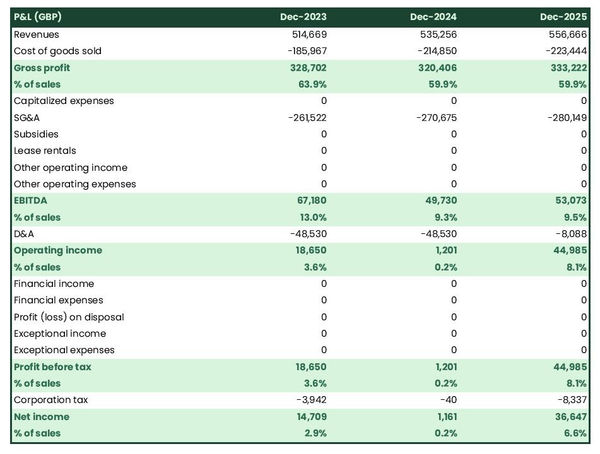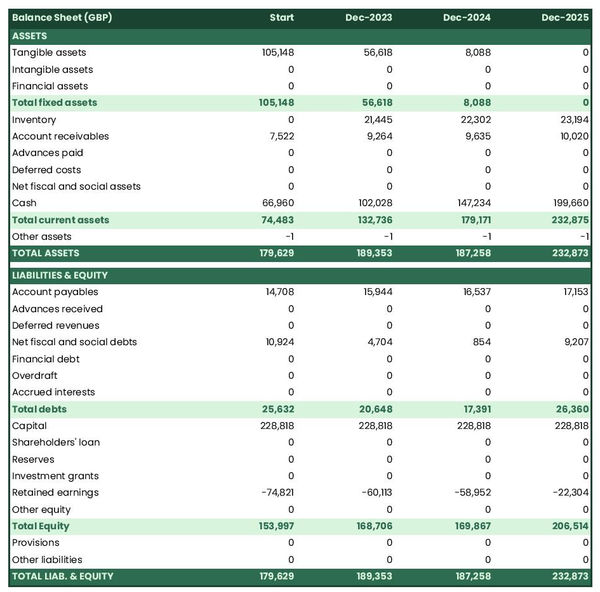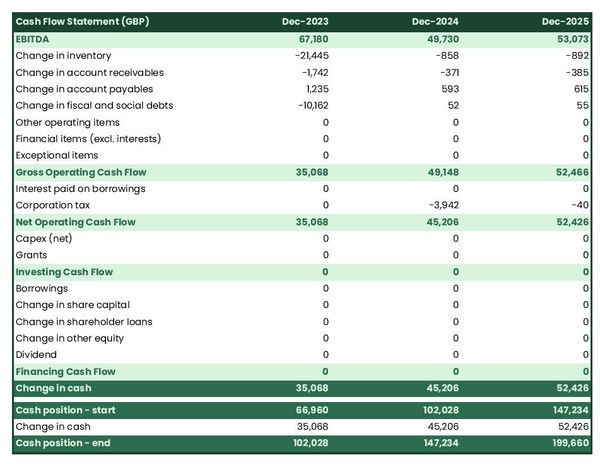How to create a financial forecast for a fishmonger shop?

Developing and maintaining an up-to-date financial forecast for your fishmonger shop is key in order to maintain visibility on your business’s future cash flows.
If you feel overwhelmed at the thought of putting together a fishmonger shop financial forecast then don’t worry as this guide is here to help you.
We'll cover everything from: the main objectives of a financial forecast, the data you need to gather before starting, to the tables that compose it, and the tools that will help you create and maintain your forecast efficiently.
Let's get started!
Why create and maintain a financial forecast for a fishmonger shop?
The financial projections for your fishmonger shop act as a financial blueprint to guide its growth with confidence and ensure its long-term financial viability.
To create them, you will need to look at your business in detail - from sales to operating costs and investments - to assess how much profit it can generate in the years to come and what will be the associated cash flows.
During challenging market conditions, maintaining an up-to-date financial forecast enables early detection of potential financial shortfalls, allowing for timely adjustments or securing financing before facing a cash crisis.
Your fishmonger shop's financial forecast will also prove invaluable when seeking financing. Banks and investors will undoubtedly request a thorough examination of your financial figures, making precision and presentation essential.
Need a solid financial forecast?
The Business Plan Shop does the maths for you. Simply enter your revenues, costs and investments. Click save and our online tool builds a three-way forecast for you instantly.

What information is used as input to build a fishmonger shop financial forecast?
A fishmonger shop's financial forecast is only as good as the inputs used to build it.
If you are creating (or updating) the forecast of an existing fishmonger shop, then you mostly need your accounting information, key historical operating non-financial data, and your team’s input on what to expect for the coming years.
If you are building financial projections for a fishmonger shop startup, you will need to have done your research and have a clear picture of your competitive environment and go-to-market strategy so that you can forecast sales accurately.
For a new venture, you will also need a precise list of the resources needed to keep the fishmonger shop running on a day-to-day basis and a list of the equipment and expenditures required to start the business (more on that later).
Let's now take a closer look at the elements that make up your fishmonger shop's financial forecast.
The sales forecast for a fishmonger shop
The sales forecast, also called topline projection, is normally where you will start when building your fishmonger shop financial forecast.
Creating a coherent sales projection boils down to estimating two key drivers:
- The average price
- The number of monthly transactions
To do this, you will need to rely on historical data (for an existing business), market research data (for both new and existing fishmonger shops), and consider the elements below:
- Seasonal Availability: As a fishmonger, your business may be affected by the availability of certain types of fish during different seasons. For example, if your shop specializes in selling wild-caught salmon, the limited availability of this fish during the winter months may affect your average price and number of monthly transactions.
- Local Regulations: Changes in local regulations or restrictions on fishing can also impact your business. For instance, if there is a ban on certain types of fishing in your area, it may result in a decrease in the supply of fish, causing your prices to increase.
- Quality of Fish: The quality of the fish you sell can greatly impact your average price and number of monthly transactions. If you consistently provide high-quality, fresh fish, customers may be willing to pay a premium price, resulting in higher average prices and more frequent transactions.
- Competition: The presence of other fishmonger shops in your area can also affect your business. If there is a lot of competition, you may need to adjust your prices to stay competitive, which could impact your average price and number of monthly transactions.
- Customer Preferences: Understanding your customers' preferences can also be a driver for your business. For example, if there is a growing trend towards sustainable seafood, offering a variety of sustainably-sourced fish may attract more customers and result in higher average prices and more transactions.
After the sales forecast comes the operating expenses budget, which we will now look into in more detail.
Need inspiration for your business plan?
The Business Plan Shop has dozens of business plan templates that you can use to get a clear idea of what a complete business plan looks like.

The operating expenses for a fishmonger shop
The next step is to estimate the costs you’ll have to incur to operate your fishmonger shop.
These will vary based on where your business is located, and its overall size (level of sales, personnel, etc.).
But your fishmonger shop's operating expenses should normally include the following items:
- Staff costs: This includes wages, salaries, and benefits for your employees, such as fishmongers, cashiers, and cleaners.
- Rent: The cost of leasing or renting your shop space in a prime location for easy access to fresh seafood.
- Utilities: Expenses for electricity, gas, water, and other utilities to keep your shop running and your seafood fresh.
- Supplies: The cost of purchasing supplies for your shop, such as packaging materials, cleaning products, and office supplies.
- Inventory: The cost of purchasing seafood from wholesalers to stock your shop and keep a variety of fresh seafood available for your customers.
- Marketing and advertising: Expenses for promoting your fishmonger shop to attract new customers and retain existing ones.
- Accountancy fees: The cost of hiring an accountant to manage your financial records and prepare tax returns.
- Insurance costs: The cost of insuring your shop, employees, and inventory against potential risks, such as theft, fire, or natural disasters.
- Software licenses: The cost of purchasing and renewing licenses for software used in your shop, such as accounting software, point-of-sale systems, and inventory management software.
- Banking fees: Expenses for bank account maintenance, transaction fees, and credit card processing fees.
- Repairs and maintenance: The cost of repairing and maintaining equipment and fixtures in your shop, such as refrigeration units, scales, and display cases.
- Waste disposal: Expenses for disposing of food waste and packaging materials in an environmentally friendly manner.
- Taxes and licenses: The cost of business licenses, permits, and taxes required to operate a fishmonger shop.
- Training and development: Expenses for training your employees on seafood handling, customer service, and other skills to ensure the quality of your products and services.
- Professional services: The cost of hiring consultants or lawyers for legal advice or other professional services.
This list is not exhaustive by any means, and will need to be tailored to your fishmonger shop's specific circumstances.
What investments are needed to start or grow a fishmonger shop?
Your fishmonger shop financial forecast will also need to include the capital expenditures (aka investments in plain English) and initial working capital items required for the creation or development of your business.
For a fishmonger shop, these could include:
- Equipment: This includes items such as refrigerators, freezers, cutting boards, knives, and other tools necessary for running a fishmonger shop.
- Display Cases: A fishmonger shop needs proper display cases to showcase the fresh seafood to customers. These can range from simple ice displays to more elaborate glass display cases.
- Storage Facilities: Proper storage is crucial for a fishmonger shop to maintain the quality and freshness of their products. This can include storage coolers, dry storage units, and shelving units.
- Vehicles: If your fishmonger shop offers delivery services, you may need to invest in a delivery vehicle. This could be a refrigerated truck or van to ensure the safe transport of your products.
- Point-of-Sale System: A modern fishmonger shop may also need to invest in a point-of-sale system to track sales, inventory, and other important financial data. This can also include other necessary software and hardware for running the business efficiently.
Again, this list will need to be adjusted according to the size and ambitions of your fishmonger shop.
Need a convincing business plan?
The Business Plan Shop makes it easy to create a financial forecast to assess the potential profitability of your projects, and write a business plan that’ll wow investors.

The financing plan of your fishmonger shop
The next step in the creation of your financial forecast for your fishmonger shop is to think about how you might finance your business.
You will have to assess how much capital will come from shareholders (equity) and how much can be secured through banks.
Bank loans will have to be modelled so that you can separate the interest expenses from the repayments of principal, and include all this data in your forecast.
Issuing share capital and obtaining a bank loan are two of the most common ways that entrepreneurs finance their businesses.
What tables compose the financial plan for a fishmonger shop?
Now let's have a look at the main output tables of your fishmonger shop's financial forecast.
The forecasted profit & loss statement
The profit & loss forecast gives you a clear picture of your business’ expected growth over the first three to five years, and whether it’s likely to be profitable or not.

A healthy fishmonger shop's P&L statement should show:
- Sales growing at (minimum) or above (better) inflation
- Stable (minimum) or expanding (better) profit margins
- A healthy level of net profitability
This will of course depend on the stage of your business: numbers for an established fishmonger shop will look different than for a startup.
The projected balance sheet
Your fishmonger shop's forecasted balance sheet enables you to assess your financial structure and working capital requirements.
It is composed of three types of elements: assets, liabilities and equity:
- Assets: represent what the business owns and uses to produce cash flows. It includes resources such as cash, equipment, and accounts receivable (money owed by clients).
- Liabilities: represent funds advanced to the business by lenders and other creditors. It includes items such as accounts payable (money owed to suppliers), taxes due and loans.
- Equity: is the combination of what has been invested by the business owners and the cumulative profits and losses generated by the business to date (which are called retained earnings). Equity is a proxy for the value of the owner's stake in the business.

The cash flow forecast
Your fishmonger shop's cash flow forecast shows how much cash your business is expected to consume or generate in the years to come.

It is best practice to organise the cash flow forecast by nature to better explain where cash is used or generated by the fishmonger shop:
- Operating cash flow: shows how much cash is generated by the operating activities
- Investing cash flow: shows how much will be invested in capital expenditure to maintain or expand the business
- Financing cash flow: shows if the business is raising new capital or repaying financiers (debt repayment, dividends)
Keeping an eye on (and regularly updating) your fishmonger shop's cash flow forecast is key to ensuring that your business has sufficient liquidity to operate normally and to detect financing requirements as early as possible.
If you are trying to raise capital, you will normally be asked to provide a monthly cash flow forecast in your fishmonger shop's financial plan - so that banks or investors can assess seasonal variation and ensure your business is appropriately capitalised.
Need a solid financial forecast?
The Business Plan Shop does the maths for you. Simply enter your revenues, costs and investments. Click save and our online tool builds a three-way forecast for you instantly.

Which tool should you use to create your fishmonger shop's financial projections?
Building a fishmonger shop financial forecast is not difficult provided that you use the right tool for the job. Let’s see what options are available below.
Using online financial forecasting software to build your fishmonger shop's projections
The modern and easiest way is to use professional online financial forecasting software such as the one we offer at The Business Plan Shop.
There are several advantages to using specialised software:
- You can easily create your financial forecast by letting the software take care of the financial calculations for you without errors
- You have access to complete financial forecast templates
- You get a complete financial forecast ready to be sent to your bank or investors
- You can easily track your actual financial performance against your financial forecast, and recalibrate your forecast as the year goes by
- You can create scenarios to stress test your forecast's main assumptions
- You can easily update your forecast as time goes by to maintain visibility on future cash flows
- You have a friendly support team on standby to assist you when you are stuck
- It’s cost-efficient and much cheaper than using an accountant or consultant (see below)
If you are interested in this type of solution, you can try our forecasting software for free by signing up here.
Hiring a financial consultant or chartered accountant
Hiring a consultant or chartered accountant is also an efficient way to get a professional fishmonger shop financial projection.
As you can imagine, this solution is much more expensive than using software. From experience, the creation of a simple financial forecast over three years (including a balance sheet, income statement, and cash flow statement) is likely to start around £700 or $1,000 excluding taxes.
The indicative estimate above, is for a small business, and a forecast done as a one-off. Using a financial consultant or accountant to track your actuals vs. forecast and to keep your financial forecast up to date on a monthly or quarterly basis will naturally cost a lot more.
If you choose this solution, make sure your service provider has first-hand experience in your industry, so that they may challenge your assumptions and offer insights (as opposed to just taking your figures at face value to create the forecast’s financial statements).
Why not use a spreadsheet such as Excel or Google Sheets to build your fishmonger shop's financial forecast?
You and your financial partners need numbers you can trust. Unless you have studied finance or accounting, creating a trustworthy and error-free fishmonger shop financial forecast on a spreadsheet is likely to prove challenging.
Financial modelling is very technical by nature and requires a solid grasp of accounting principles to be done without errors. This means that using spreadsheet software like Excel or Google Sheets to create accurate financial forecasts is out of reach for most business owners.
Creating forecasts in Excel is also inefficient nowadays:
- Software has advanced to the point where forecasting can be done much faster and more accurately than manually on a spreadsheet.
- With artificial intelligence, the software is capable of detecting mistakes and helping decision-making.
Spreadsheets are versatile tools but they are not tailor-made for reporting. Importing your fishmonger shop's accounting data in Excel to track actual vs. forecast is incredibly manual and tedious (and so is keeping forecasts up to date). It is much faster to use dedicated financial planning tools like The Business Plan Shop which are built specially for this.
Need a convincing business plan?
The Business Plan Shop makes it easy to create a financial forecast to assess the potential profitability of your projects, and write a business plan that’ll wow investors.

Use our financial projection templates for inspiration
The Business Plan Shop has dozens of financial forecast templates available.
Our examples contain a complete business plan with a financial forecast and a written presentation of the company, the team, the strategy, and the medium-term objectives.
Whether you are just starting out or already have your own fishmonger shop, looking at our financial forecast template is a good way to:
- Understand what a complete business plan should look like
- Understand how you should model financial items for your fishmonger shop

Takeaways
- A financial projection shows expected growth, profitability, and cash generation for your business over the next three to five years.
- Tracking actuals vs. forecast and keeping your financial forecast up-to-date is the only way to maintain visibility on future cash flows.
- Using financial forecasting software makes it easy to create and maintain up-to-date projections for your fishmonger shop.
You have reached the end of our guide. We hope you now have a better understanding of how to create a financial forecast for a fishmonger shop. Don't hesitate to contact our team if you have any questions or want to share your experience building forecasts!
Need inspiration for your business plan?
The Business Plan Shop has dozens of business plan templates that you can use to get a clear idea of what a complete business plan looks like.

Also on The Business Plan Shop
Know someone who runs or wants to start a fishmonger shop? Share our financial projection guide with them!






